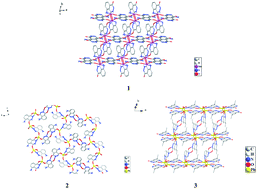By the simple hydrothermal self-assembly, four new monoacylhydrazidate-coordinated compounds [Mn(APTH)2(H2O)] 1, [Pb(APTH)2]·0.25H2O 2, [Pb2(EPDH)4(H2O)] 3 and [Pb(MPDH)2] 4 (APTH = 3-aminophthalhydrazidate, EPDH = 5-ethylpyridine-2,3-dicarboxylhydrazidate, MPDH = 6-methylpyrinde-2,3-dicarboxylhydrazidate) were obtained. It is noteworthy that APTH was derived from the in situ reduction reaction of NPTH (3-nitrophthalhydrazide) with N2H4·H2O as the reducer, whereas EPDH and MPDH were derived respectively from the in situ acylation reactions of epdca and mpdca (epdca = 5-ethylpyridine-2,3-dicarboxylic acid, mpdca = 6-methylpyridine-2,3-dicarboxylic acid) with N2H4·H2O. The photoluminescence analysis indicates that compounds 3 and 4 possess luminescence properties with maximum emissions at 531 nm for 3, and 600 nm for 4, respectively. The density functional theory (DFT) calculations indicate that the emission for compound 3 can be ascribed to a combination of the intra-ligand and inter-ligand charge transfers, while the emission for compound 4 is assigned to the intra-ligand charge transfer.

